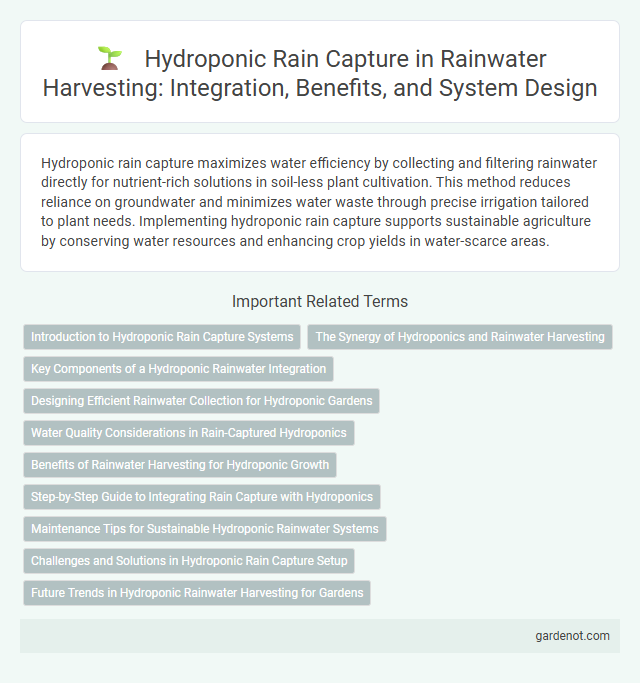Hydroponic rain capture maximizes water efficiency by collecting and filtering rainwater directly for nutrient-rich solutions in soil-less plant cultivation. This method reduces reliance on groundwater and minimizes water waste through precise irrigation tailored to plant needs. Implementing hydroponic rain capture supports sustainable agriculture by conserving water resources and enhancing crop yields in water-scarce areas.
Introduction to Hydroponic Rain Capture Systems
Hydroponic rain capture systems integrate rainwater harvesting with soil-less cultivation methods to optimize water use efficiency. These systems channel collected rainwater directly to hydroponic setups, reducing reliance on traditional water sources and minimizing runoff pollution. By combining sustainable water management with controlled nutrient delivery, hydroponic rain capture enhances plant growth while conserving natural resources.
The Synergy of Hydroponics and Rainwater Harvesting
Hydroponic rain capture integrates rainwater harvesting with soil-free plant cultivation, optimizing resource efficiency and reducing water waste. This synergy enhances nutrient delivery by using purified rainwater, promoting healthier plant growth and minimizing contamination risks. Implementing hydroponic systems within rainwater harvesting frameworks maximizes sustainable urban agriculture and conserves water resources in drought-prone regions.
Key Components of a Hydroponic Rainwater Integration
Key components of a hydroponic rainwater integration system include rainwater collection surfaces such as rooftops or specially designed catchments, filtration units to remove debris and contaminants, and storage tanks to hold purified water. Nutrient delivery systems are critical for supplementing essential minerals in the water, ensuring optimal plant growth in the hydroponic setup. Pumps and automated controllers regulate water flow and nutrient distribution, maintaining precise conditions for efficient hydroponic cultivation using harvested rainwater.
Designing Efficient Rainwater Collection for Hydroponic Gardens
Designing efficient rainwater collection for hydroponic gardens involves integrating rooftop catchment systems with advanced filtration to ensure nutrient-rich water supply. Utilizing UV filtration and sediment traps enhances water purity, preventing clogging in hydroponic channels and promoting plant health. Optimizing storage tanks with automated sensors helps maintain consistent water availability, crucial for hydroponic nutrient cycles.
Water Quality Considerations in Rain-Captured Hydroponics
Hydroponic rain capture systems require careful water quality management to prevent nutrient imbalances and microbial contamination, ensuring optimal plant growth. Monitoring parameters such as pH, electrical conductivity, and the presence of heavy metals or pathogens is essential for maintaining a safe and efficient nutrient solution. Regular testing and filtration techniques improve water purity, enhancing the sustainability and productivity of rain-captured hydroponic setups.
Benefits of Rainwater Harvesting for Hydroponic Growth
Rainwater harvesting provides purified, nutrient-rich water ideal for hydroponic systems, reducing reliance on municipal water and lowering operational costs. Utilizing harvested rainwater enhances plant growth by supplying essential minerals naturally absent in tap water, promoting healthier and faster crop yields. This sustainable practice conserves water resources, minimizes chemical use, and supports eco-friendly agricultural productivity.
Step-by-Step Guide to Integrating Rain Capture with Hydroponics
Implementing hydroponic rainwater harvesting involves first installing a rooftop or surface rain capture system with gutters and storage tanks. Next, filter and channel collected rainwater into a hydroponic nutrient reservoir, ensuring proper pH and mineral balance for optimal plant growth. Finally, connect the reservoir to the hydroponic system's irrigation lines, enabling efficient distribution of natural, nutrient-enriched water directly to the roots.
Maintenance Tips for Sustainable Hydroponic Rainwater Systems
Regular cleaning of filters and storage tanks prevents algae buildup and maintains water quality in hydroponic rain capture systems. Inspecting pump functionality and ensuring proper nutrient balance supports optimal plant growth and system efficiency. Monitoring pH levels frequently and replacing worn components prolongs system lifespan and sustainability.
Challenges and Solutions in Hydroponic Rain Capture Setup
Hydroponic rain capture systems face challenges such as inconsistent rainfall patterns, nutrient imbalance, and contamination risks from pollutants in collected water. Advanced filtration technologies and automation in nutrient monitoring optimize water quality and maintain plant health, while modular designs enhance system adaptability to fluctuating water availability. Implementing real-time sensors and smart irrigation controls further mitigates water scarcity issues, promoting efficient resource use in hydroponic agriculture.
Future Trends in Hydroponic Rainwater Harvesting for Gardens
Hydroponic rain capture systems in gardens are evolving with enhanced filtration technologies and smart sensors that optimize water collection and nutrient delivery. Integration of IoT-enabled devices allows real-time monitoring of water quality and precise irrigation scheduling, improving plant growth and water conservation. Future trends emphasize sustainability by combining renewable energy sources with automated rainwater harvesting to create fully self-sufficient urban gardens.
Hydroponic rain capture Infographic

 gardenot.com
gardenot.com